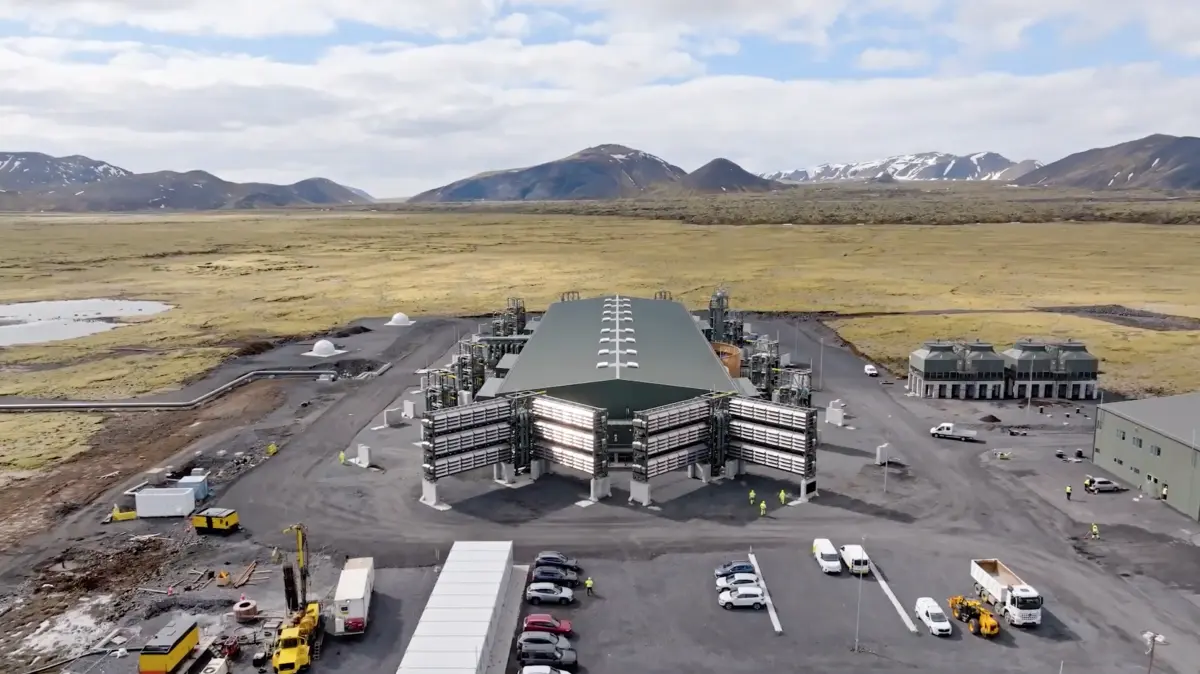Can I just say that for me, the way that people respond to these things is the most demotivating of all. When ever anything is done, as long as it is not the perfect solution it is the wrong solution. We all know that the best solution would be a complete turn around from what current standards are. Stop eating so much meat, take a bike, invest in infrastructure that reflects sunlight. Tax the rich (or eat them), invest in nuclear, etc. People know this and a lot of people try. And for me, any company that also at least tries to do something should be lauded in stead of the flood of negative remarks. I would love it if my kids, who constantly hear that they will have to survive in hell, would sometimes get a glimmer of optimistic or supportive remarks to read as well.
The problem is, projects like this turn our heads away from the real problems. Politicians and investors will justify not reducing greenhouse gas emissions because we have this new technology which will save us all. Fact is, climate change has already been solved, we know what we have to do since decades. It is not a problem which will be solved by technology, it is a political problem. In addition to that people will say that they are doing enough by investing in carbon capture but will not address the biodiversity crisis which can only be addressed by proposing real environmental policy change.
It should be called C02 capture (make the CO2 part specific). The carbon which was burned was already safely captured in the ground, where it should have stayed. Then it was burned and partly turned into CO2. Lots of it. Who is being -paid- to concentrate the stuff? and bury the stuff? And keep an eye on it? Who will pay that bill?
In Satartia Mississippi on February 22 2020, a CO2 pipeline broke because of a mud slide. 45 people were hospitalized after the 21,600 barrels of liquid CO2 rolled downhill towards their town. https://www.desmoinesregister.com/story/money/agriculture/2022/09/11/here-minute-details-2020-mississippi-co-2-pipeline-leak-rupture-denbury-gulf-coast/8015510001/
Once you’ve captured this particular form of carbon, you have to store it somewhere. FOREVER. Unlike nuclear waste, it’s only visible when it’s compressed. Does this mean you have to take someone’s word that it was captured? It -does- mean you have to accept that it’s safely and securely stored. FOREVER. ‘We promise.’
The whole thing is at best sketchy. The same money could be invested in real, tangible generation of renewable energy. Without having to take some sketchy industry’s word for it. And without potentially endangering the lives of the people who’ll have to live with it next door. Would you rather live near a windmill, or a hole with 36,000 tons of CO2 in it?
Totally agree. Same with electric cars. Yes, they are not great. But we need to find a way to reduce emissions rapidly. Which means re-using already built infrastructure. Which is, as much as it sucks, roads.
It’s not the most kid friendly metaphor but I tend to look at it as “the bucket of fucks”. Everything you give a fuck about has a certain amount of weight and there is an nigh infinite amount of things to give a fuck about. But you are a person, you can only carry around so many fucks or else the fuck bucket gets too heavy to move. Having an immovable fuck bucket is dispiriting so you give up.
But the people who are generally successful in resolving the fucks for everyone generally select a couple manageable ones for themselves to handle. But you have to invest DEEP into that fuck. But you know what? Making progress on something is relative. This achievement is HUGE to the people who invested in this particular thing to give a fuck about and it is making things a little better. We can afford to be a little inspired while realizing that all the things in our own fuck buckets are important too.
So according to statista in 2023 global emissions were 37.5 billions of tons, and exponentially growing since 1944.
In the article they say they can remove 36,000 tons of CO2 and the goal is
For the world to achieve “carbon neutrality” by 2050, “we should be removing something like six to 16 billion tons of CO2 per year from the air,”
That’s a drop in the bucket alright. Sustainability and capitalism (with its embedded exponential growth) cannot coexist.
It’s not even a drop in the bucket. A drop maybe contains 0.1 ml, a bucket contains 10l, so that’s 0.001%. This is way less of the needed volume of capture, 0.000225%.
did nobody involved in this project see the irony of calling it a carbon capture plant?
Has anyone done the math and figured out if these things are more efficient than trees? I have my doubts but I’m also a pleb so idk how to compare them.
I haven’t done the math but I studied a lot energy stuff for my degree. I can say for sure that’s it’s a hell of a lot more money and work than just reducing emissions in the first place. The below comment is accurate, if cynical; I knew someone who works on it in the states. You collect a bunch of co2 (using energy), then compress it (with energy), then ship it (yep diesel trucks), to salt caves where it is pumped (with energy) into the empty salt lined cave where the pressure causes the salt to sort of seal in a partial melt from the pressure. And hope we don’t accidentally frack it all back out. Needless to say I think it’s a waste of technology, money, and political will that’d be better spent on a plethora of other options.
Here in Iceland, where this is located, we produce more green energy than we consume and can’t store that energy, and the carbon is pumped straight into the basalt below which absorbs it. I think doing it here is a decent way to do research on improving the technology.
Yea it’s a good tool in places that have unlimited energy sources nearby, like geothermal or hydroelectric
I mean just looking at the amount of concrete in that picture, I get pessimistic. When will this particular site have dug itself out of the carbon “hole” created by its construction?
As for trees: That is really, really hard to measure and even harder to know in advance. Some factors appear to be:
- different tree species store different amounts of carbon
- tree plantation or actual forest?
- prior use of the site (e.g. meadows do store carbon too)
- development over time (most trees need to grow a couple years before they start storing significant amounts of carbon)
- failure of sites due to being planted in a bad way (e.g. a lot of Chinese Green Wall sites and quick-buck billion tree projects seem to be affected by this)
IIRC, a tree absorbs up to 3 tons/year, and takes a bunch of years to get to that stage.
The trees also don’t sequester underground, and will need surface area staying as forest for the rest of time.
As many have echoed: an ounce of prevention saves a pound of cure. Most bang for our buck would be to change our lifestyle and regulations. But as that’s not feasible we’re at the geo engineering and artificial sequestration stage.
I don’t know what more efficient means here. The CO2 is stored sorta permanently underground, whereas trees release their CO2 when they rot or burn.
Trees are kind of better because they grow on their own, and don’t require massive amounts of green energy to scrub the atmosphere.
CO2 generally is released in cycles. Wood rots, new forests grow etc. The biggest issue is that we went from slow cycles such as carbon is stored in fossil fuels that VERY slowly release CO2 through natural processes, to extremely rapid release of CO2.
How do you measure “efficiency” ? By money spent? Then yes, trees are currently cheaper. But trees are complicated (see other comments). Additionally, even if we cover the whole landmass with trees, there is still a catastrophic amount of Co2 left in the atmosphere.
than* trees
What a giant waste of resources.
Right? It sequesters 0.0001% of our annual carbon output. They say they hope to reduce the cost to $400-$600/ton by 2030 so,even using their 2030 estimate, this plant cost $14.4M - $28.8M. To sequester 1% of our current carbon emissions per year would cost $144B - $288B. $7.2T - $14.4T to do 50%.
This doesn’t sound like a productive use of the limited R&D funds that go into combating climate change.
The plant works just as intended and has already captured a lot of that sweet sweet greentech R&D money and subsidies.
You know… that actually doesn’t seem that bad when you consider that the global GDP was 90T in 2022 - assuming linear scaling, sequestering the entire global carbon footprint would take 30% of global GDP.
Assuming that the economy grows (let’s say 3%/yr) with lower carbon intensity (i.e we do some of the other things on the climate change bucket list) and manage to prevent emissions from growing, the global GDP surplus by 2030 would cover sequestering the costs for capturing all global emissions.
Now that’s just napkin maths - and carbon capture is terribly inefficient and seems like an upper bound of cost. So, now consider how much less it might cost if we use efficient methods: Renewables, nuclear, HVACs, hydrogen steel, co2-binding concrete etc etc.
Eh, just a thought.
Where is it burying that CO2? In oil wells? Nearly all carbon capture projects are just greenwashing oil extraction.
Tey press it in the ground near volcsnos where it turns into limestone. The plant is powered by geothermal.
I don’t think there’s a lot of oil around volcanos. Iceland isn’t known for it, at least.
A sizable carbon tax is the best way we can handle this that I can think of.
36,000 tons a year and how energy is needed to sequester this piddling mount of CO2? Leaving the pre-sequestered stuff on n the ground is definitely cheaper. Bring on the carbon tax.
I shared the article because it is relevant to this community but I personally do not like carbon capture. You don’t need to capture what you don’t create
Thanks for the article. Your thoughts are probably similar to mine in that carbon capture probably is part of the solution but it’s hard to see how the volume of CO2 captured can be ramped up enough to be meaningful. It is certainly meaningless if we don’t stop burning fossil fuels.
I think they should aim to turn all that CO2 to carbon fiber. That way they could sell it and and have a profit. That way would lead to others building their own capture plants (if there’s money to win…).
That’s one of the big goals, plants like this are important too because they allow the tech to be developed and tested so we have real world numbers to work with when planning and designing for commercial applications







